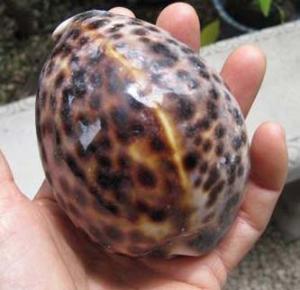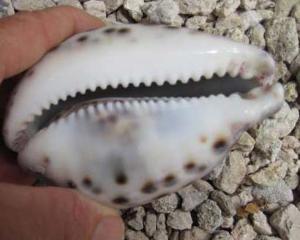Published in the Ocean Watch column, Honolulu Star-Advertiser © Susan Scott
August 16, 2010

While snorkeling off a windward beach, I found a marine animal on the ocean floor in about 10 feet of water. The creature lay buried in the sand, belly up, with just its teeth showing. I could barely believe my good fortune. If I hadn’t by chance been looking right at that s
pot, I would never have seen it.
Much as I love living, breathing marine animals, I felt a tinge of excitement that this one was long dead. And since sand filled its cavity, it clearly contained no squatters. I dived down, picked up the skeleton and swam to the shore break where I sand-scoured algae and other marine growth off its edges.
I’d found the shell of a glorious, mature tiger cowry.
Cowry shells are shaped like half an egg, the upper part curved (pictured at left), the bottom flat with a slit along its length. A row of blunt projections called teeth line each side of the slit, but these teeth have nothing to do with eating.
Cowries, and all marine snails, eat with a tonguelike band of tissue in the mouth called a radula. This organ bears tiny teeth that scrape algae, sponges and other invertebrates from hard surfaces.
 Cowry snails’ diets vary according to species. Some eat seaweed, some eat sponges and others eat both. Tiger cowries are vegetarians, grazing only on algae. Cowries are famous for covering up in fleshy sweaters called mantles. The mantle extends from each side of the cowry’s slit, slides up over the back of the shell and meets in the middle. These living wraps continually lay down layers of shiny, protective enamel, and they’re beautiful in themselves. Often brightly colored and bearing frilly projections, cowry mantles provide camouflage to these often conspicuous snails.
Cowry snails’ diets vary according to species. Some eat seaweed, some eat sponges and others eat both. Tiger cowries are vegetarians, grazing only on algae. Cowries are famous for covering up in fleshy sweaters called mantles. The mantle extends from each side of the cowry’s slit, slides up over the back of the shell and meets in the middle. These living wraps continually lay down layers of shiny, protective enamel, and they’re beautiful in themselves. Often brightly colored and bearing frilly projections, cowry mantles provide camouflage to these often conspicuous snails.
Most cowry species, including the tiger, are nocturnal, hiding during the day and roaming the reef at night, cloaked in their lacy mantles.
Cowries are among the few marine snails that sit on their eggs. The female covers her eggs with her muscular foot for several weeks until they hatch. Initially, the babies drift in the ocean as plankton. When they settle down as juveniles, their shells are thin and almost cone-shaped. These grow quickly to adult size, and then the shells slowly thicken.
Hawaii hosts 35 cowry species. Nine of these are found nowhere else in the world.
The misnamed tiger cowries (they have spots, not stripes) are cosmopolitan, living throughout the Indian and Pacific oceans from shallow tide pools to depths of about 300 feet. Hawaii’s are the largest in the world, growing to 6 inches long.
The one I found is 4 inches long, big for a Hawaii cowry these days since these snails have been killed extensively for their shells.
Because of collecting, tiger cowries are harder to find in Hawaii than they once were and are now rare in most places.
Humans have always considered seashells treasures. That will never change. What we can change, though, is the way we collect them.
We can help cowries, and all marine snails, by not buying or trading in shells in which the snail was killed for its shell. Also, before taking a shell home, make sure it isn’t occupied by a hermit crab. Our reefs need these busy little recyclers to stay healthy.
My cowry shell now decorates my desk. I consider it a fine gift from a remarkable animal.